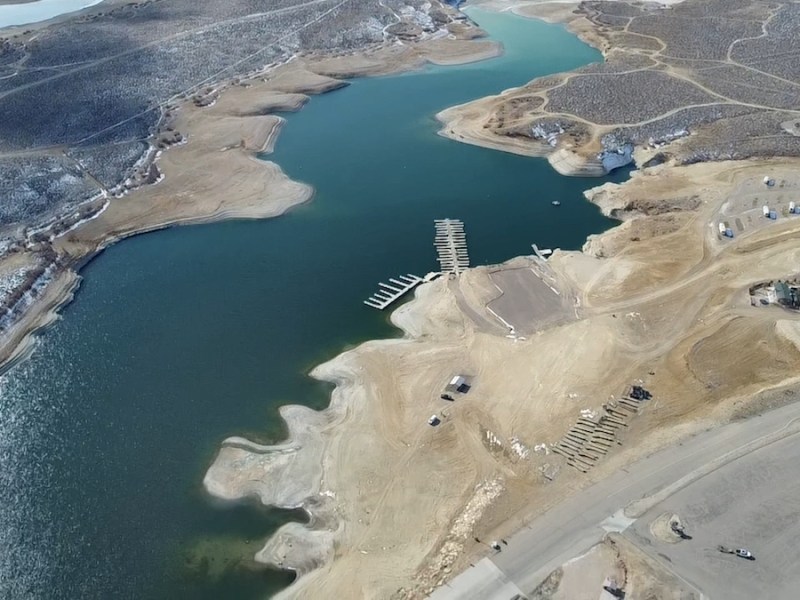

Shortly after the ice came off in 2023, Pete Cavalli went to scout the conditions at Little Soda Lake in anticipation of an annual rite of spring: stocking the little water body outside of Pinedale with rainbow trout.
Even though the water was still cold, it was noticeably greener than usual. There was also a lot of manure around the shoreline, he said.
“The smell was overwhelming,” said Cavalli, a longtime fisheries biologist for the Wyoming Game and Fish Department’s Pinedale Region. “That definitely was a huge factor in recommending not stocking that year.”
In the year that followed, conditions at the little lake perched above mighty Fremont Lake and visible from Skyline Drive took an abrupt turn for the worse. No trout were stocked into the outletless, roughly 50-acre lake that spring, nor this year, and it ceased being a fishery. By this fall, the Wyoming Department of Environmental Quality sent word of a harmful cyanobacteria bloom, a notification that it was potentially not safe to swim or let animals drink the water.
Notably, the bloom did not live up to the colloquial name: blue-green algae. Instead, Little Soda Lake turned a striking shade of red.

A hunter reported the mysterious water color, reminiscent of a mine tailings pond, in early November. Soon, Game and Fish and the Bridger-Teton National Forest were coordinating with each other and trying to determine what was going on.
“We don’t have enough information yet,” said Bridger-Teton National Forest staffer Jill McMurray, who handles water quality sampling. “Eucapsis, the main cyanobacteria species that the state identified in the sample, can turn red.”
More typically, however, Eucapsis is green or bluish-green, said Eric Hargett, Wyoming DEQ’s water quality standards program supervisor.
“In Wyoming, we typically do not see cyanobacteria blooms display in reddish colors,” he said. “It’s possible that the reddish color may be related to some other bacteria.”
Another possible explanation, according to McMurray, is that the organic matter that bloomed died when the lake “turned over” and the colder, deeper water mixed with the surface water. The phenomenon, combined with Little Soda’s unique chemistry, could have caused the color change.
“Kind of like how leaves turn red in the fall,” McMurray said.

Some members of the Pinedale community have posited that cattle crowding the small water hole over the summer played a role in the changes. The domestic stock’s presence is spelled out in the muddy banks, which were covered with cattle tracks and manure throughout the summer months of 2024.
McMurray believes it’s too early to make that judgement. Other backcountry lakes in the Winds have struggled with harmful cyanobacteria blooms without cattle grazing, she said, including three near Big Sandy Opening in 2024: V Lake, Twin Lakes and Meeks Lake. There’s more attention on harmful blue-green algae, even in the backcountry, than ever before, though oftentimes the environmental phenomenon feeding the cyanobacterial blooms is not straightforward.
One thing is clear about Little Soda Lake: It’s not likely to be a trout water anytime soon.
“It’s a non-fishery,” said Cavalli, the fisheries biologist. “It was a pretty popular fishery [previously], especially among Soda Lake anglers.”

With a water column reaching down more than 50 feet, the small lake once overwintered some stocked trout. Cavalli used to measure the oxygen content of the water, but he stopped years ago after finding that the lake was anoxic even at the surface — an oxygenless, lethal condition for fish.
The viability of the fisheries in Little Soda Lake and its larger neighbor, Soda Lake, have clearly been affected by climactic changes in the Green River Basin.
“All the evidence points to the fact that we’ve been in the long-term drought,” Cavalli said. “We’re not getting the moisture that we used to get, and [Soda Lake] is going down every year.”
Soda Lake, once renowned for its trout fishing, has dropped by about 15 feet from the high point decades ago, Cavalli said. Little Soda’s water level hasn’t fallen as dramatically, but it’s still declined by 6 to 8 feet, he said.

Even Soda Lake, about six times larger than Little Soda, is at risk of ceasing to be a functional fishery. At its peak in 1997, an estimated 47,000 trout called Soda Lake home. Estimates most years are now under 1,000, Cavalli said, and there are no easy solutions to make it better.
At the fishery already lost — Little Soda — Cavalli and his state and federal counterparts will be watching to see what happens.
“I thought when the temperatures dropped, the cyanobacteria would die back and it would clear up,” the fisheries biologist said. “But obviously, it’s still happening — whatever it is.”
Photos Game and Fish biologists took from aerial flights in early December showed the reddish colored water is persisting even under the ice.

The DEQ plans to conduct additional monitoring at Little Soda Lake, Hargett said.
McMurray at the Bridger-Teton intends to help. Come next summer, she aims to test for nitrogen, phosphorus, nitrate, ammonium and phosphate — and also help get a read on cyanotoxins that might exist.
“We need to collect more information,” McMurray said, “and then figure out all the pieces.”
“It’s not just one thing that’s causing this problem,” she added. “The biggest thing is probably climate change and the change in the water table. And then there are other variables probably exacerbating this issue.”
BEFORE YOU GO… If you learned something from this article, pay it forward and contribute to WyoFile. Our work is funded by readers like you who are committed to unbiased journalism that works for you, not for the algorithms.
The post A once-beloved Pinedale fishing hole turned red and no one knows why appeared first on WyoFile .



